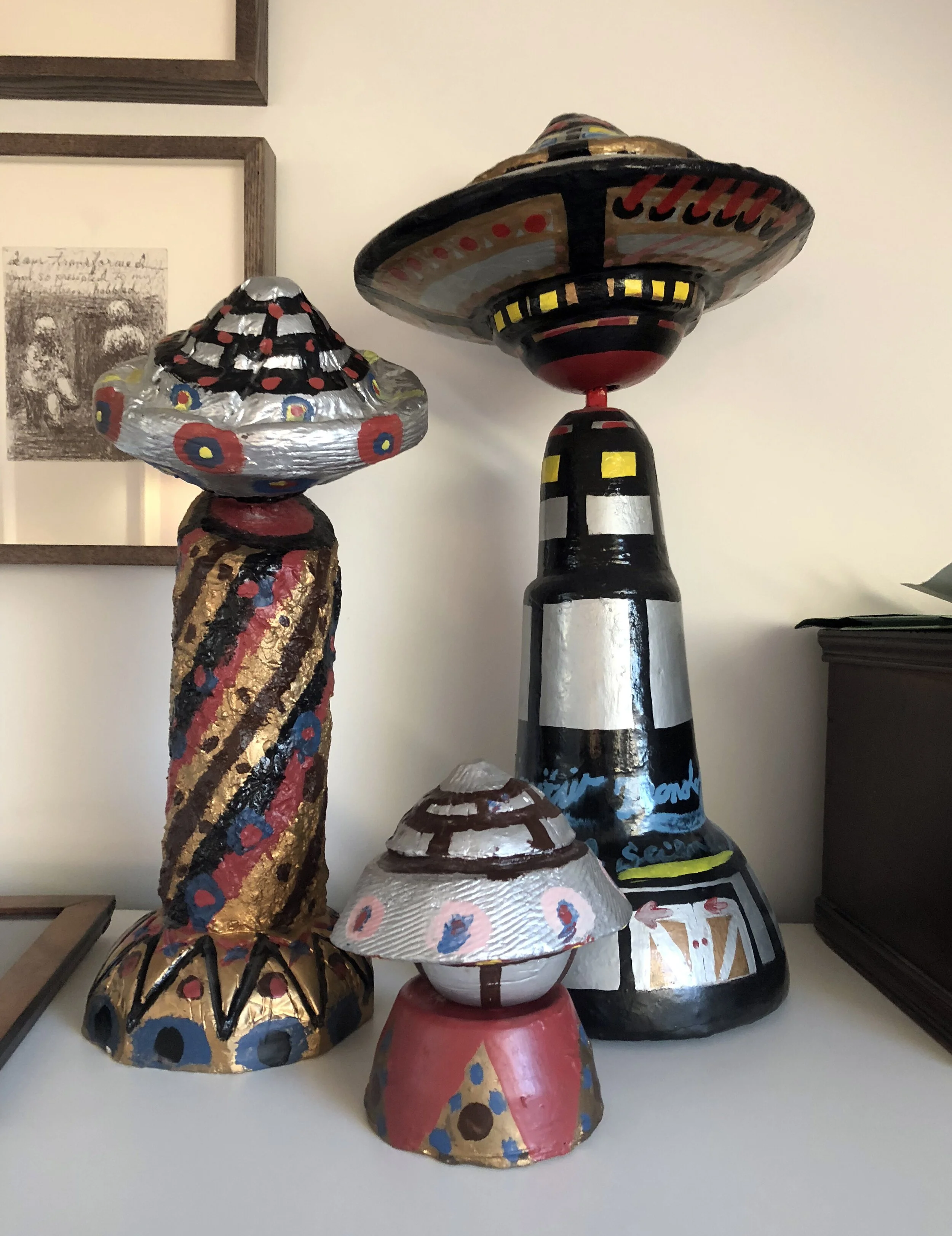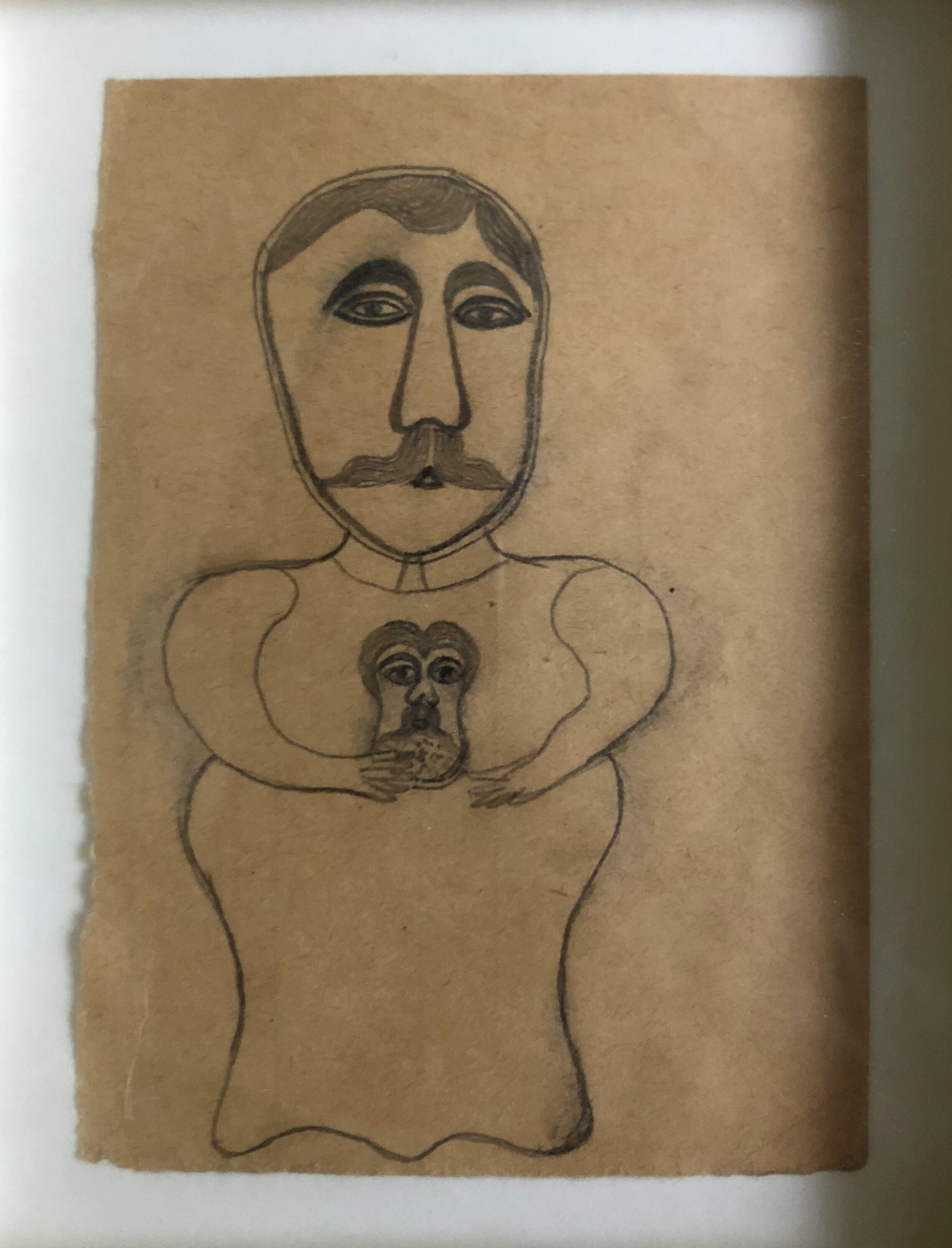Adam Whitaker, UK - MEET THE COLLECTOR Series Part Fifty Three
Adam Whitaker, a friendly face from the UK, makes up part fifty-three of my ‘Meet the Collector’ series. I was introduced to Adam a few years ago through Henry Boxer and Colin Rhodes and after hearing more and more about his exquisite collection, I wanted to delve deeper. Read on to hear from Adam and his love of this field of art…
Joe Coleman, Henry Boxer and Adam Whitaker in the Odditorium
1. When did your interest in the field of outsider/folk art begin? Can you tell us a bit about your background – I heard that you trained as a graphic designer? And do you see any relationship between your taste in outsider art and your background in art and design?
I studied Graphic Design at St Martins back in the late 80’s. In my first year David Jones was our Head of Year. He came in one day waving the very first issue of Raw Vision, which he had designed. Not only did it contain radical typography and daring page layouts (vertical type, lots of white space), it was also full of weird and wonderful art. I remember the environments - I think it must have been the Watts Towers, and Augustin Lesage sitting at that massive canvas in the famous photo. Back then St Martins wasn’t the slick commercial operation it is today. It had a reputation for unrivalled creativity, and the both students and staff alike were a real eclectic collection of oddballs. Talented oddballs, but definitely oddballs. Other colleges had the kit (rows of the first ever Apple Macs – brand new!) and the industry connections, whereas we had to make our own desks on our first day. This kind of art really appealed to us.
Actually, I just realised that the first time I saw this kind of art would have been when my sister (older/cooler) bought me the Little Creatures album by Talking Heads for Christmas in 1985. By then I was already well on my way to being a vinyl junkie (my other collecting foible) - in love with those 12 inch covers almost as much as the music. I remember the fascination with the Howard Finster cover – to me it fitted so perfectly with the music. I think at that time I thought David Byrne had painted it.
Howard Finster
2. When did you become a collector of this art? How many pieces do you think are in your collection now? And do you exhibit any of it on the walls of your home or elsewhere?
My wife Serena is responsible for getting me into collecting Outsider Art. She bought me my very first pieces for my birthday – two fabulous Talpazan’s. I found his story fascinating, and his art even more extraordinary… and that was it I was hooked. We’ve just moved house, so there’s not much up at the moment. There’s an Edmund Monsiel I was given recently (!) which I love above my desk, and one of our first Talpazan UFO’s is in my son’s room. He’s also a big fan. I’m looking forward to unpacking everything and seeing it afresh in a new space. I’m not sure how many pieces there are in total, but there is a lock-up somewhere near Heathrow that would make a great episode of Storage Hunters.
3. A conflicted term at present, but can you tell us about your opinion of the term outsider art, how you feel about it and if there are any other words that you think we should be using instead?
There’s a problem with trying to label such a diverse, varied and rich field of work with one term – Outsider art isn’t a movement like Surrealism or Futurism – it doesn’t have a unified aim. Far from it. Often the artists don’t even think of what they are doing as art, it’s a compulsion. It’s like trying to find a unifying term that can describe water polo, darts and pole vaulting. Yes, they are all sports, but there the similarities end.
4. What style of work, if any, is of particular interest to you within this field? (for example is it embroidery, drawing, sculpture, and so on)
I tend to lean towards work that has a spiritualist or mediumistic aspect… things with that otherworldly quality that you can’t quite put your finger on - a bit of mystery. People who are trying to make sense of their world in a unique way or by using alternative systems. Artists like Madge Gill, George Widener, A. G. Rizzoli…
A. G. Rizzoli
5. Would you say you are more interested in the more well-known artists of this field, or do newer more unexposed artists appeal to you as well?
The recognised outsider greats can always knock you sideways. Even if you have seen something reproduced many times, they tend to be even more magnificent in real life. That’s not so true of all mainstream art. You don’t tend to get the ‘Oh-The- Mona-Lisa-Is-Actually-Really-Small-In-Real-Life’ moment so often with famous outsider works.
On the other hand, there’s nothing quite so thrilling as a new discovery that’s the real deal. The fact that these stories aren’t lost in time is often pure chance. A tiny detail here or there - someone not looking at that box on the kerbside or a relative thinking all those drawings in the loft were junk - and it’s gone forever. It’s fragility and ability to survive is a powerful combination. I remember being shown the work of William Hall for the first time and I was blown away, it was so remarkable.
William Hall
6. Would you say you had a favourite artist or piece of work within your collection? And why?
Talpazan has always been my first and true love. But my favourite piece would have to be a Lesage we bought in Paris when my son was just about to be born. It’s a wonderful thing. We didn’t quite dare call our son Lesage, but we did give it to him as a middle name (more as an opportunity for embarrassment at a later age).
Augustin Lesage
7. Where would you say you buy most of your work from: a studio, art fairs, exhibitions, auctions, or direct from artists?
It varies. I spend a lot of time looking for new things, but nowadays I’m looking for something really special that has a place in my collection. Much of my collection has come from Henry Boxer. I have lots of things I like, but everything from Henry I love.
8. Is there an exhibition in this field of art that you have felt has been particularly important? And why?
I suppose some might say it isn’t really an exhibition, but I love the Outsider Art Fair. Unpretentious, exciting, well curated and organised – it’s everything that a great art show should be. Imagine never having heard of Outsider Art and just wandering in there. There should probably be some sort of warning over the door. “Caution! Mind altering art inside!”
Angelika
9. Are there any people within this field that you feel have been particularly important to pave the way for where the field is at now?
I would say Henry Boxer. He has an incredible eye and a knack for finding amazing new discoveries.
10. Is there anything else you would like to add?
Given the year that we have all just had, Outsider Art has never been more relevant than it is now. We are all going to need these special visionaries more than ever.
George Widener








